You’re likely no stranger to the challenges of cultivating life in dark corners of your home.
But what if you could bring some greenery into those areas without sacrificing style or sanity? Low-maintenance plants are the answer, and you’re about to discover some of the best ones for low-light conditions.
From the elegant Chinese Evergreen to the versatile Pothos, these plants will thrive in the shadiest spots, requiring minimal care and attention.
But which ones will work best for you, and how can you guarantee they flourish?
Low-Maintenance Plant Options

Several low-maintenance plants thrive in low-light conditions, making them perfect for busy individuals or those new to indoor gardening.
You can place them in forgotten corners of your home, where natural light is scarce. These plants require minimal care, allowing you to focus on other aspects of your life.
Easy watering is a key benefit, as you won’t need to constantly monitor their moisture levels. In fact, some plants can survive with infrequent watering, making them ideal for those who tend to forget.
Chinese Evergreen Varieties
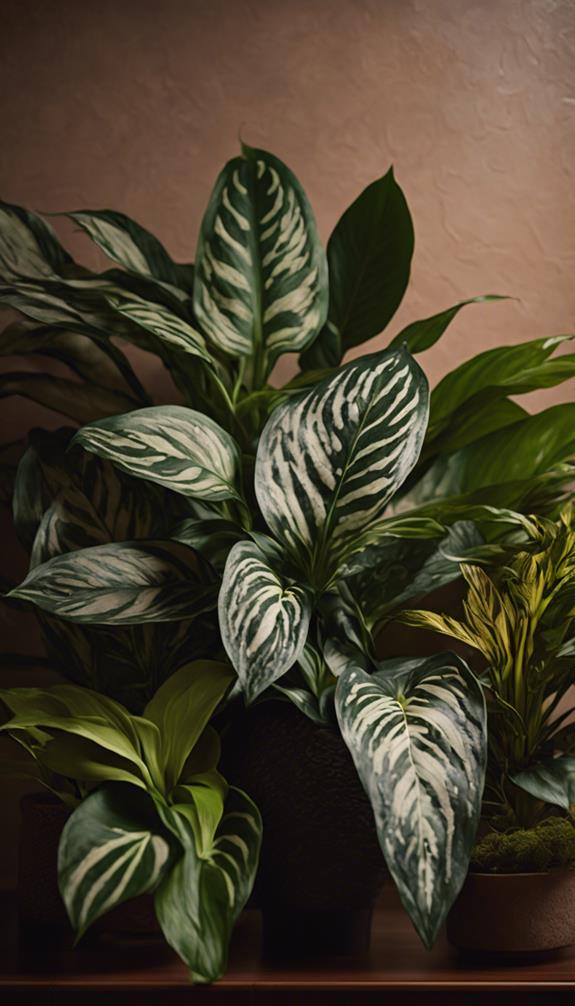
The Chinese Evergreen, a popular low-maintenance plant, boasts over 20 distinct varieties, each offering unique characteristics and growing conditions.
You’ll find varieties like ‘Silver Queen’ and ‘Marble Queen’ that feature striking silver and grey hues, perfect for adding a touch of sophistication to your Evergreen landscapes.
Other varieties, such as ‘Red Emerald’ and ‘Luna Red’, showcase deep red and pink tones, making them ideal for adding Leafy accents to your space.
When selecting a Chinese Evergreen variety, consider factors like leaf shape, size, and color to find the perfect fit for your indoor space.
With proper care, these plants thrive in low-light conditions, making them an excellent choice for rooms with limited natural light.
Pothos Plant Care Tips
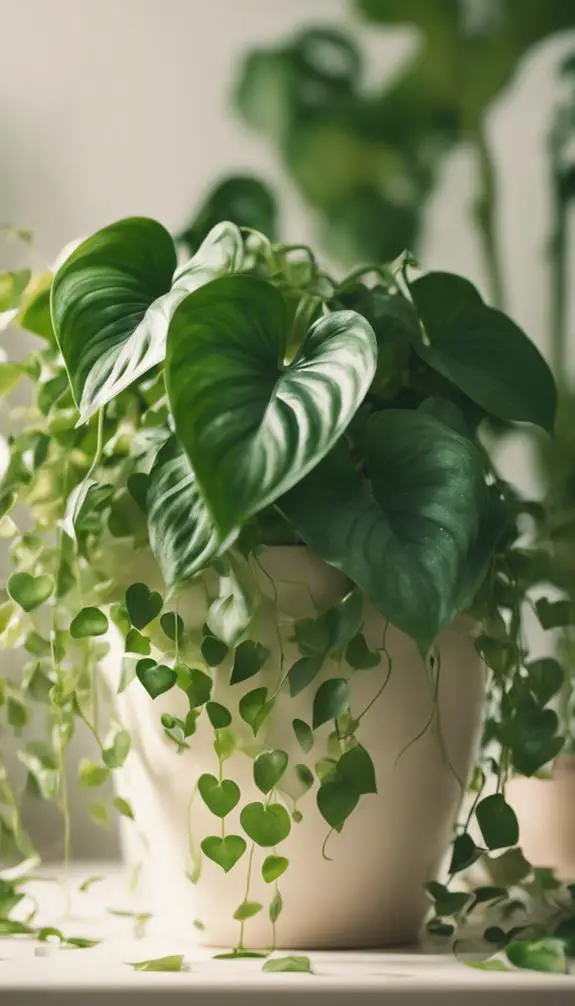
You’re likely drawn to Pothos plants because of their ability to thrive in low-light conditions, but to keep them happy and healthy, you’ll need to provide proper care.
Water them sparingly, allowing the top inch of soil to dry out between waterings.
Pothos pruning is essential to maintain their trailing shape and encourage new growth.
Remove any dead or damaged leaves, and cut back long vines to encourage branching.
Pothos fertilizing is also vital; feed your plant with a balanced, water-soluble fertilizer during the growing season (spring and summer).
Dilute the fertilizer to half the recommended strength to avoid burning the roots.
ZZ Plant Benefits Explained
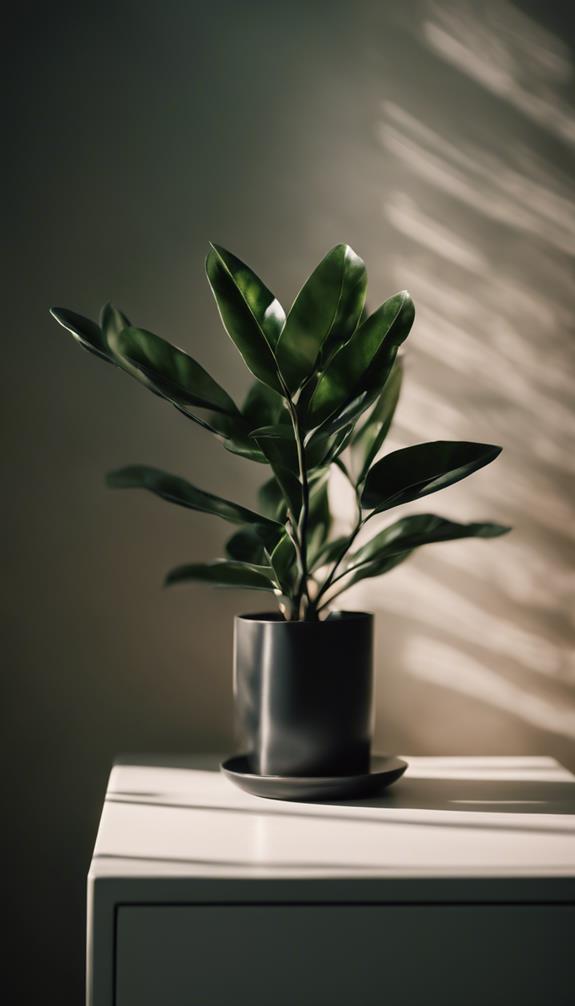
Thriving in low-light conditions, the ZZ Plant has earned its reputation as a low-maintenance, high-reward indoor plant.
You’ll appreciate its ability to tolerate neglect, making it perfect for busy individuals or those new to plant parenthood.
The ZZ Plant’s history dates back to Africa, where it grew in dry, rocky areas, adapting to survive in harsh conditions.
This resilience translates to your home, where it’ll enhance indoor aesthetics with its glossy, dark green leaves.
With minimal watering and pruning required, you can focus on enjoying its benefits, like air purification and stress reduction.
Peace Lily Decor Ideas
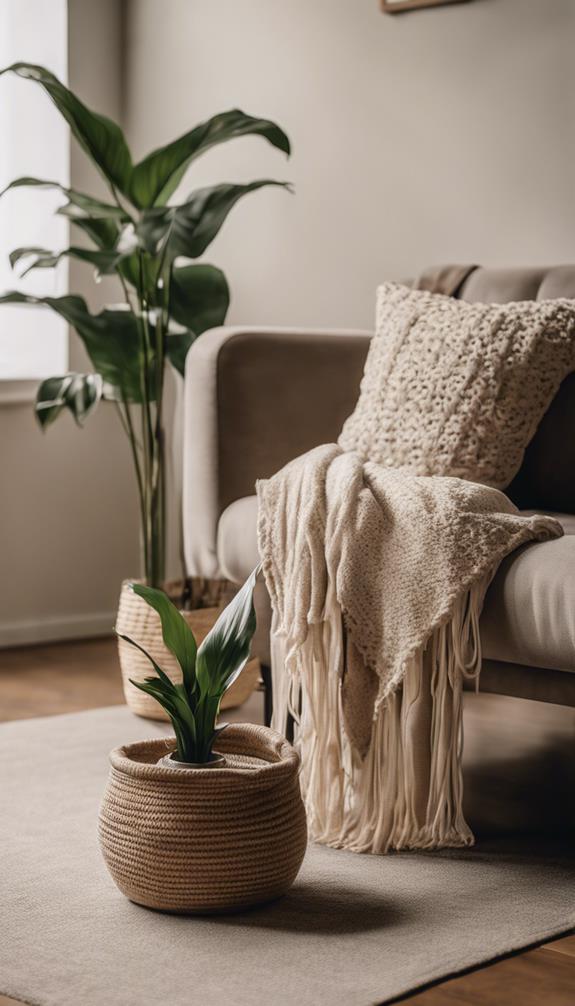
As you explore the world of low-maintenance plants, your attention turns to incorporating them into your home decor.
Peace lilies, with their elegant white blooms and dark green leaves, can elevate any space. To create peaceful spaces, place a single peace lily on a side table or shelf, allowing its natural beauty to shine.
For a more dramatic look, create lily arrangements by grouping multiple plants together in a decorative planter. This will add a touch of sophistication to any room.
Consider pairing peace lilies with other low-maintenance plants, like snake plants or ZZ plants, to create a harmonious and thriving indoor oasis. By incorporating peace lilies into your home decor, you’ll create a serene atmosphere that invites relaxation and rejuvenation.
Snake Plant Air Purification

You’ll be pleased to know that snake plants are natural air purifiers, working to purify indoor air naturally by absorbing pollutants and releasing oxygen.
They’re particularly effective at removing toxins like formaldehyde, benzene, and trichloroethylene from the air, making your indoor space a healthier environment.
Purifying Indoor Air Naturally
Air pollution is a pervasive issue, and indoor spaces are no exception.
You may think air purifiers are the solution, but did you know that certain plants can also act as natural filters? They’re a cost-effective and eco-friendly alternative to traditional air purifiers.
As you bring plants into your home, you’re not only beautifying your space but also creating a healthier environment. Snake plants, for instance, are known to remove pollutants like formaldehyde and benzene from the air.
Removing Toxins Efficiently
Your decision to incorporate snake plants into your indoor space is a great step towards purifying the air you breathe.
These plants are highly efficient at removing toxins, making them an excellent natural remedy for air purification. Snake plants can absorb pollutants like formaldehyde, benzene, and trichloroethylene from the air, breaking them down into harmless compounds.
This process occurs through a complex system of roots, stems, and leaves that work together to purify the air.
By incorporating snake plants into your space, you’re taking a proactive approach to air purification, creating a healthier environment for yourself and others.
This natural solution isn’t only effective but also low-maintenance, making it an ideal choice for those seeking innovative ways to improve indoor air quality.
Dracaena Compacta Styles

You’ll find that Dracaena Compacta styles offer a range of design options to fit your space, from compact globes to slender pillars.
To keep your plant thriving, you’ll need to understand the essential care requirements, including watering, fertilization, and pruning.
Plant Care Essentials
Three key elements comprise the foundation of plant care essentials for Dracaena Compacta Styles: adequate watering, suitable temperature, and controlled humidity.
You’ll want to water your plant when the top 1-2 inches of soil feel dry to the touch, taking care not to overwater which can lead to root rot.
Maintain a temperature range of 65-75°F (18-24°C) to promote healthy growth.
Controlled humidity levels between 40-60% will also support your plant’s development.
Certify your pot has good drainage holes to prevent waterlogged soil conditions, which can be detrimental to your plant’s health.
Design Options Available
The Dracaena Compacta Style‘s versatility in design allows it to seamlessly integrate into various interior spaces, making it a popular choice for home and office decor.
You can customize its appearance to fit your modern decor by selecting from a range of pot styles, materials, and colors.
For an urban aesthetic, pair the plant with industrial-chic planters or geometric-shaped pots in bold colors.
Alternatively, opt for minimalist planters in neutral tones to create a clean and sophisticated look.
You can also experiment with different textures, such as woven baskets or ceramic pots, to add depth and visual interest to your space.
With its adaptability, the Dracaena Compacta Style is sure to complement your unique design vision.
Philodendron Heartleaf Care
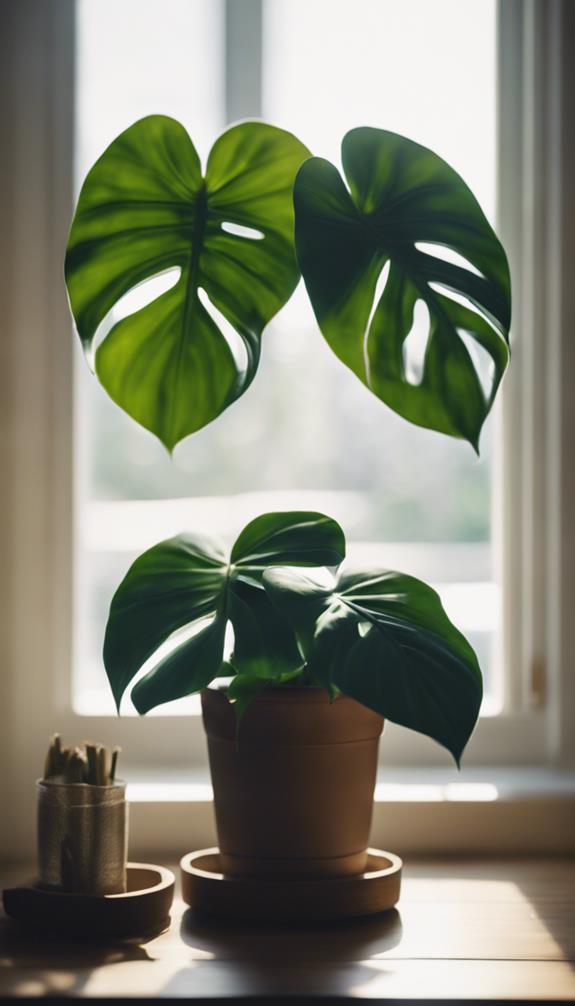
Your Philodendron Heartleaf’s survival depends on providing it with the right conditions.
To thrive, it needs moderate to bright indirect light, but not direct sunlight, which can cause scorched leaves. Maintain a consistent temperature between 65°F to 75°F (18°C to 24°C) and humidity above 50%.
Water your Philodendron Heartleaf when the top inch of soil feels dry, avoiding overwatering that can lead to root rot. Fertilize sparingly during the growing season with a balanced fertilizer.
Prune long vines to encourage bushy growth and remove dead or damaged leaves. With proper care, your Philodendron Heartleaf will display stunning foliage patterns and unique leaf shapes, adding beauty to your low-light space.
Peperomia Watering Schedule

Watering your Peperomia becomes a delicate balancing act in low-light conditions, where the plant’s ability to photosynthesize is already compromised.
You’ll need to adjust your watering schedule to prevent waterlogged Peperomia soil, which can lead to root rot. Check the soil moisture by sticking your finger into the soil up to the first knuckle. Water only when the top inch of soil feels dry.
Reduce watering frequency during winter months when the plant is dormant. Fertilize sparingly during the growing season, as Peperomia fertilization can be detrimental in low-light conditions.
A balanced, water-soluble fertilizer applied at half the recommended strength will suffice. By following these guidelines, you’ll create an ideal environment for your Peperomia to thrive in low light.
Calathea Prayer Plant Guide
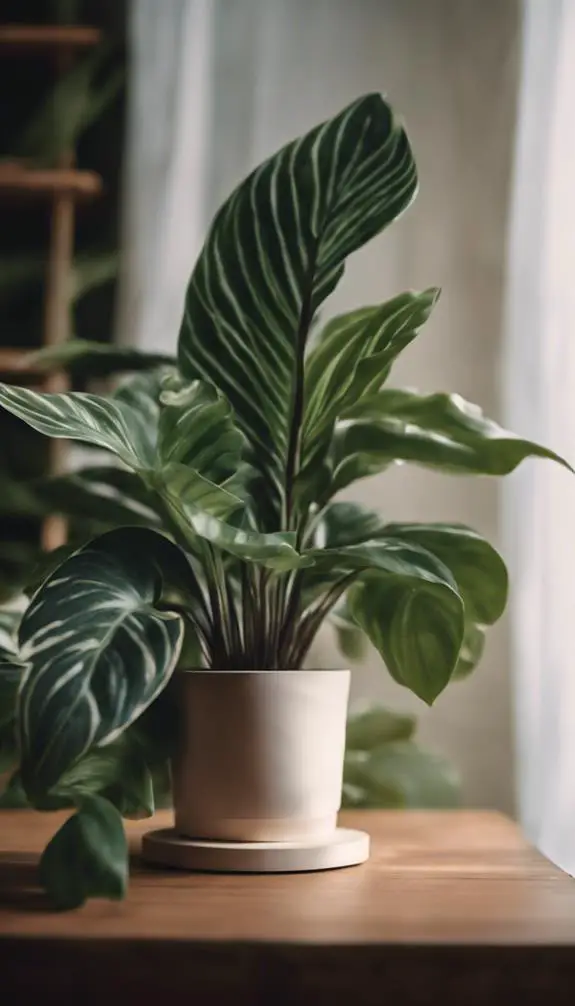
You’re about to discover the world of Calathea prayer plants, which thrive in low-light conditions.
To get started, you’ll need to understand the Calathea care essentials, including soil, temperature, and humidity requirements.
From there, you can explore the various prayer plant varieties and determine the ideal lighting conditions for your chosen species.
Calathea Care Essentials
While calatheas are known for their stunning foliage, they can be finicky when it comes to their environment, requiring specific conditions to thrive.
To keep your Calathea species happy, you’ll need to provide bright, indirect light and maintain a consistent temperature between 65-75°F (18-24°C).
Watering is vital, as these plants prefer moist soil, but be careful not to overwater, which can lead to root rot.
Humidity levels should be kept high, ideally above 50%.
For successful Calathea propagation, divide the roots during the spring or summer when the plant is actively growing.
Repot your calathea every 1-2 years to refresh the soil and provide a larger pot if necessary.
Prayer Plant Varieties
Beyond the general care requirements, Calathea species offer a diverse range of varieties, each with unique characteristics and growing conditions.
You’ll find over 300 species, including the popular Prayer Plant (Maranta leuconeura), which has been a staple in homes since the 19th century.
This variety is known for its beautiful, unique foliage and its ability to fold its leaves at night, resembling praying hands – hence the name “Prayer Plant”.
In many cultures, the Prayer Plant is seen as a symbol of gratitude and spiritual growth, adding an extra layer of meaning to its presence in your home.
When choosing a Calathea variety, consider factors like leaf pattern, color, and growth habits to find the one that best fits your space and style.
Lighting Requirements
Calathea Prayer Plants thrive in low-light conditions, making them a great addition to rooms with limited natural light.
When it comes to natural lighting, east- or west-facing windows are ideal, as they provide gentle, indirect light. Avoid direct sunlight, which can cause leaf scorch.
If natural light is scarce, you can supplement with artificial illumination. Fluorescent lights or LED grow lights work well, providing the necessary spectrum and intensity for healthy growth.
Aim for 10-12 hours of artificial illumination per day, and adjust the distance and duration based on the plant’s response. By providing the right amount of light, you’ll be rewarded with vibrant, thriving Calathea Prayer Plants.
Spider Plant Propagation
Frequently, you’ll find yourself with a spider plant that’s outgrown its container, and that’s when propagation becomes essential.
To propagate, you’ll need to remove the spider plantlets, also known as spiderlings, from the mother plant. Look for the spiderlings with developed roots and leaves, usually surrounded by a visible spider web pattern.
Cut the stem connecting the spiderling to the mother plant, leaving about an inch of stem attached to the spiderling. Plant the spiderling in a new pot filled with a well-draining mix, and water thoroughly.
Keep the soil consistently moist to promote healthy Spiderling growth. With proper care, your new spider plant will thrive in low-light conditions, producing more spiderlings and continuing the cycle.
Parlor Palm Lighting Needs
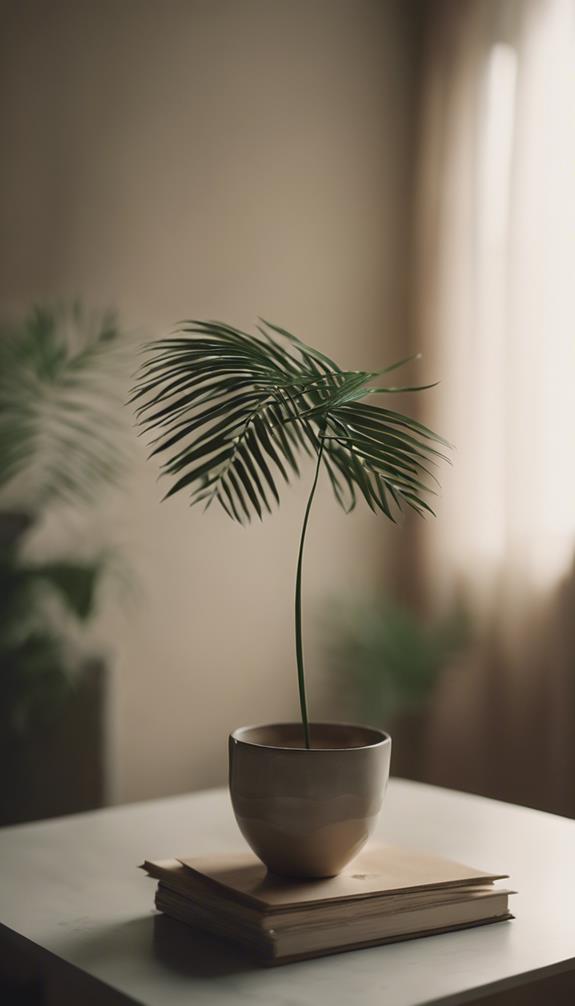
When situating your parlor palm in a low-light setting, it’s vital to strike a balance between providing sufficient light and avoiding harsh direct sunlight, which can cause scorching.
As a general rule, palm trees require bright, indirect light, especially when they’re young. East- or west-facing windows are ideal for parlor palms, as they receive gentle, filtered light.
However, if you can’t provide natural light, you can use grow lights with a low to moderate intensity. Avoid placing your parlor palm in a spot with intense direct sunlight, especially during peak hours, as this can cause leaf scorch and discoloration.
Waxy Leafed Plants Showcase
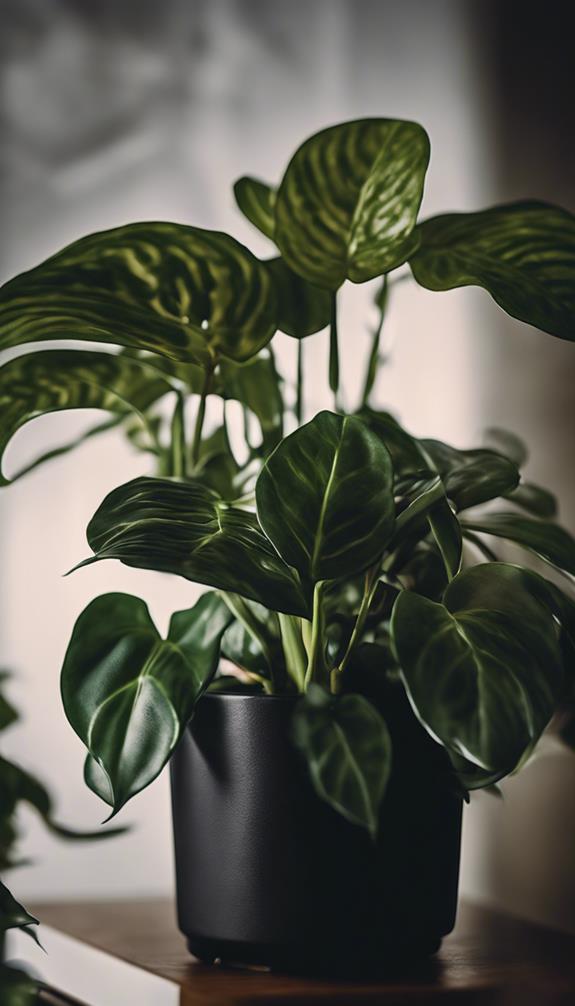
You’ve likely noticed that some indoor plants boast leaves with a waxy, glossy finish.
These waxy wonders thrive in low-light conditions, making them perfect for rooms with limited natural light. The leafy textures of these plants are adapted to conserve water, allowing them to survive with minimal moisture.
Examples of waxy leafed plants include Peperomia, Chinese Evergreen, and Pothos. These plants have evolved to store water in their leaves, stems, or roots, enabling them to tolerate low-light conditions.
Their adapted features make them ideal for indoor spaces with limited natural light. By incorporating these plants into your space, you can bring in a touch of greenery even in the darkest corners.
Frequently Asked Questions
Can Indoor Plants Thrive in a Room With No Windows?
You can still grow thriving plants in a windowless room by leveraging artificial illumination to compensate for the lack of natural light, even in shadowy spaces where most plants would typically struggle to survive.
How Often Should I Rotate My Indoor Plants for Even Growth?
You should rotate your indoor plants every 1-2 weeks to guarantee even growth, as this allows each side to receive ideal light exposure and adjust to changes in plant direction, promoting balanced development.
Are All Low-Light Plants Suitable for Basements With No Natural Light?
You’ll find that not all plants thrive in basements with zero natural light; however, some species can tolerate artificial lighting, and you’ll need to choose ones adapted to extreme basement conditions, ensuring you provide sufficient supplemental lighting to meet their needs.
Can I Use Grow Lights to Supplement Natural Light for Indoor Plants?
You can definitely use grow lights to supplement natural light for indoor plants, exploring grow light options that mimic the light spectrum, such as LED or HPS lights, to provide the ideal spectrum for your plants’ growth and development.
Will Indoor Plants Attract Pests Like Mosquitoes or Spiders?
When bringing plants indoors, you’ll want to know that they can attract pests like mosquitoes or spiders, which are drawn to pest attractants like moisture and organic matter.
Conclusion
You’ve explored the best indoor plants for low light, learning about low-maintenance options that thrive in scarce natural light.
From Chinese Evergreen’s varied species to Pothos’ adaptable nature, each plant offers unique benefits.
The ZZ Plant’s low-water needs, Peace Lily’s elegant appearance, and Calathea’s prayer-like foliage make them stand out.
Spider Plant’s easy propagation, Parlor Palm’s flexibility, and waxy leafed plants’ striking visuals round out the list. Now, choose the perfect plant to brighten up your indoor space.




